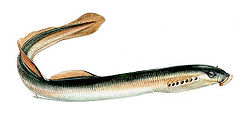Biology
Unlike some species of lamprey, the adults do not migrate to the sea and do not have a parasitic phase. During the spawning time adult brook lampreys do not feed. Brook lampreys spawn in spring and summer in shallow areas of streams and sometimes lakes in gravel close to the soft sediment in which they were previously resident. Both males and females create pits by removing small rocks with their mouths and fanning smaller particles with their tails. The male and female deposit sperm and eggs, simultaneously while intertwined, into the nest. The female can release several thousand eggs, up to 100,000 for some species. Adult brook lamprey spawn in small groups and die soon after spawning. [5]
The eggs hatch within a few days, after which the young larvae bury themselves in soft sediment with only the mouth protruding. The young lampreys are blind filter feeders, feeding on detritus and other organic matter for three to five years before maturing. After spending four years as ammocoetes (Larva), these lampreys metamorphose to adults in the fall and spawn the following spring. This process is complete after the maturation of the gonads. Eyes and suction disk also develop during this time, while the intestinal tract degenerates and loses its function. The full transformation can take up to a year. Thus, these fish develop their teeth precisely when they are no longer able to eat. However, lampreys have been observed gripping stones with their teeth [6] in order to build nests, showing that the teeth do have a function.
This page is based on this
Wikipedia article Text is available under the
CC BY-SA 4.0 license; additional terms may apply.
Images, videos and audio are available under their respective licenses.





